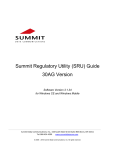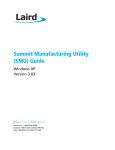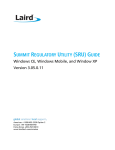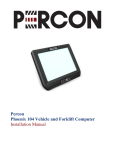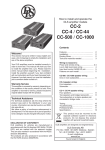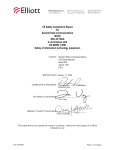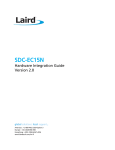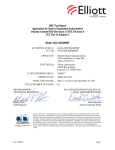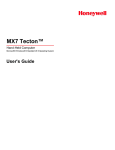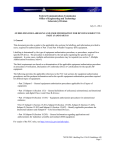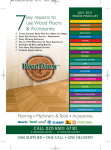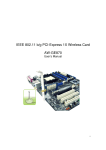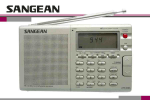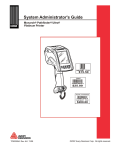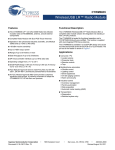Download Device Certification Guide
Transcript
Device Certification Guide Version 1.0 Americas: +1-800-492-2320 Europe: +44-1628-858-940 Hong Kong: +852 2923 0610 www.lairdtech.com/wi-fi Device Certification Guide REVISION HISTORY Revision Date Description 1.0 19 January 2015 Converted from HTML document. Embedded Wireless Solutions Support Center: http://ews-support.lairdtech.com www.lairdtech.com/bluetooth 2 Laird Technologies Americas: +1-800-492-2320 Europe: +44-1628-858-940 Hong Kong: +852 2923 0610 Device Certification Guide Contents Revision History ............................................................................................................................................ 1 Regulatory Domains .................................................................................................................................... 4 MIC (Japan) ............................................................................................................................................................... 4 ETSI ........................................................................................................................................................................... 4 Current versions of ETSI certifications: ................................................................................................................ 5 KC .............................................................................................................................................................................. 5 NCC ........................................................................................................................................................................... 5 Industry Canada ........................................................................................................................................................ 6 Industry Canada ID Number ................................................................................................................................. 6 FCC ............................................................................................................................................................................ 6 FCC ID ................................................................................................................................................................... 6 FCC Grant Conditions of Certified Modules ......................................................................................................... 7 Modular Approval ................................................................................................................................................ 7 Limited Modular Approval ................................................................................................................................... 8 DFS Compliance.................................................................................................................................................... 9 Summit Regulatory and Summit Manufacturing Utilities ...................................................................... 10 Laird Wi-Fi Radio Certifications ................................................................................................................ 10 Wi-Fi Alliance ............................................................................................................................................. 11 Cisco Compatible Extensions Compliance ................................................................................................ 11 RoHS Compliance ....................................................................................................................................... 11 Non-Disclosure Agreements ...................................................................................................................... 12 Frequently Asked Questions (FAQ) ........................................................................................................... 12 Embedded Wireless Solutions Support Center: http://ews-support.lairdtech.com www.lairdtech.com/bluetooth 3 Laird Technologies Americas: +1-800-492-2320 Europe: +44-1628-858-940 Hong Kong: +852 2923 0610 Device Certification Guide REGULATORY DOMAINS The main regulatory bodies that exercise authority over most of the world's technology regulations are FCC, IC, ETSI, MIC, and KCC. MIC (Japan) (formerly TELEC) - Ministry of Interanal Affairs and Communications ETSI - European Telecommunications Standards Institute KC - Korea Certification IC - Industry Canada FCC - Federal Communications Commission NCC - National Communications Commission (Taiwan) MIC (Japan) Ministry of Internal Affairs and Communications (MIC) is the standards body for Japan. For more information visit: http://www.telec.or.jp/eng/index.html For MIC certifications, all approvals and certifications must exist at the device level, rather than the radio module level. Device vendors may leverage Laird's certifications and the associated test report when applying for MIC certifications. Article 2 Item 19, Category WW (2.4 GHz Channels 1 - 13) Article 2 Item 19-2, Category GZ (2.4 GHz Chanel 14) Article 2 Item 19-2, Category XW (5150-5250 W52 & 5250-5350 W53) Article 2 Item 19-2, Category YW (5470-5725 W56) ETSI European Telecommunications Standards Institute (ETSI) is the standards body for most of Europe, Africa, the Middle East, and parts of Asia. For more information visit: http://www.etsi.org According to the Radio and Telecommunications Terminal Equipment (R & TTE) Directive, the manufacturer must issue a Declaration of Conformity (DoC) indicating device compliance with the basic requirements of applicable directives. For ETSI certifications, all Laird radio certifications may be leveraged by mobile and portable device vendors as part of their self-declaration to obtain the CE mark required by members of the European Union. Note: ETSI/CE rules differ from those of the FCC and IC in that there is no provision from a modular approval. All approvals and certifications must exist at the device, rather than the radio module level. In some situations, the module's current test reports may not be adequate to support a DoC for the end product: Environmental extremes - The host (end) product may be marketed for a higher or different temperature range or a different voltage range than what was included in the module's original testing. Antenna - The antenna gain used by the host product may be different than the module's original test reports. Software - The host product may not fully incorporate some of the features present in the operating software used in the original module tests. Embedded Wireless Solutions Support Center: http://ews-support.lairdtech.com www.lairdtech.com/bluetooth 4 Laird Technologies Americas: +1-800-492-2320 Europe: +44-1628-858-940 Hong Kong: +852 2923 0610 Device Certification Guide Module modifications - The integrator may have to modify the module to allow it to operate properly in the host system. If so, the integrator must have a thorough understanding of the impact the changes may have on each of the module tests. Current versions of ETSI certifications: EN 300 328 (v1.7.1) Electromagnetic compatibility and Radio spectrum Matters (ERM); wideband transmission systems; Data transmission equipment operating in the 2.4 GHz ISM band and using wide band modulation techniques; Harmonized EN covering essential requirements under article 3.2 of the R & TTE Directive EN 301 893 (v1.5.1) (a/b/g modules) Broadband Radio Access Networks (BRAN); 5 GHz high performance RLAN; Harmonized EN covering the essential requirements of article 3.2 of the R & TTE Directive EN 301 489-1 (v1.8.1) (Council Directive 2004/108/EC on Electromagnetic Compatibility) Electromagnetic compatibility and Radio spectrum Matters (ERM); Electromagnetic Compatibility (EMC) standard for radio equipment and services; Part 1: Common technical requirements EN 301 489-17 (v2.1.1) (Council Directive 2004/108/EC on Electromagnetic Compatibility) Electromagnetic compatibility and Radio spectrum Matters (ERM); Electromagnetic Compatibility (EMC) standard for radio equipment; Part 17: Specific conditions for Broadband Data Transmission Systems EN 60950-1 (2006+A1:2010) (Council Directive 2006/95/EC on Low Voltage Equipment Safety) EN 62311:2008 (Assessment of electronic and electrical equipment related to human exposure restrictions for electromagnetic fields) EU 2002/95/EC (RoHS - Restriction of Hazardous Substances) KC Korea Certification (KC) is the standards body for Korea. On February 29, 2008, the former Ministry of Information and Communications (MIC) and the Korea Broadcasting Commission (KBC) merged to form the Korea Communications Commission (KCC) which covered EMC, Radio, and Telecom certification. As of January 24, 2011, the KCC mark was unified to KC (Korea Certification). For more information visit: KCC Certification Policy (PDF). NCC The National Communications Commission (NCC), established in February of 2006, is the first legitimate regulatory agency in Taiwan that is independent from an executive branch. This commission is responsible for the regulation of telecommunications, information, and broadcasting sectors. The following four policies make up the administrative principles of NCC: Promote the sound development of communications Safeguard individuals' rights Protect consumers' interests Raise multicultural diversity For more information visit: http://www.ncc.gov.tw/ Laird Wi-Fi radios with NCC certification are certified to the following NCC standard: LP0002 (100-06-28) - Technical regulations for low power radio-frequency devices for the radiated and conducted emissions of international radiators. Embedded Wireless Solutions Support Center: http://ews-support.lairdtech.com www.lairdtech.com/bluetooth 5 Laird Technologies Americas: +1-800-492-2320 Europe: +44-1628-858-940 Hong Kong: +852 2923 0610 Device Certification Guide Industry Canada Industry Canada (IC) is the regulatory agency and standards body for Canada. For more information visit: http://www.ic.gc.ca/Intro.html IC Certifications are based on FCC certification testing using the same antennas and transmit power and covering the same frequency bands. Test reports and data sheets relevant to IC certification may be found in the FCC section for the applicable Laird radio,here. Laird Wi-Fi radios are certified to the IC RSS-210 standard. RSS-210 Radio Standards Specification RSS-210, Issue 8, License-exempt Radio Apparatus (All Frequency Bands): Category I Equipment RSS-Gen Issue 2 General Requirements and Information for the Certification of Radio Communication Equipment Industry Canada ID Number An IC-certified device must be labeled with a unique certification number which includes: Company Number (CN) - Assigned by Industry Canada. Made up of (at most) six alphanumeric characters (A-Z, 0-9). Unique Product Number (UPN) - Assigned by the applicant. Made up of (at most) eight alphanumeric characters (A-Z, 0-9). Example: MSD30AG IC ID - 6616A-SDCMSD30AG 6616A = Company Number (CN) SDCMSD30AG = Unique Product Number (UPN) FCC The Federal Communications Commission is the regulatory agency and standards body for the Americas and parts of Asia. For more information, visit: http://www.fcc.gov/ Laird Wi-Fi radios hold the following FCC grants: Part 15.247 Subpart C DTS (Digital Transmission System) specification Part 15.407 Subpart E Requirements for UNII Devices The FCC certification process varies depending on the type of device you plan to certify. Portable Device (such as Handheld Device) - Portable device vendors must secure an FCC grant for their devices rather than leverage an existing grant at the module (radio) level. Mobile Device (such as a Vehicle Mounted Device) - FCC rules allow vendors to use current FCC grants for their mobile devices without additional testing or certification only if certain conditions are met. FCC ID The FCC ID is a three letter grantee code followed by up to 14 characters of your choice. The ID can only consist of alphanumeric characters and the hyphen. The grantee code (the FCC Registration Number or FRN) is Embedded Wireless Solutions Support Center: http://ews-support.lairdtech.com www.lairdtech.com/bluetooth 6 Laird Technologies Americas: +1-800-492-2320 Europe: +44-1628-858-940 Hong Kong: +852 2923 0610 Device Certification Guide assigned to you by the FCC. If this is the first time your company is making a submittal, the grantee code will be assigned just prior to making the submittal; otherwise, you use the previously assigned code. Example: MSD30AG FCC ID - TWG-SDCMSD30AG Refer to the following topics for additional information: FCC Grant Conditions of Certified Modules Modular Approval Limited Modular Approval Portable Devices Mobile Devices DFS Compliance Permissive Change FCC Grant Conditions of Certified Modules When integrating a certified wireless module into end host products, you must consider the specific FCC grant conditions for each wireless module. Common module conditions include: Implementation of the module according to the manufacturer's installation guidelines. Operation distance from the human body. If the end host product device operates close to the human body (within 20 cm), then SAR testing may be required. Collocation restrictions with other radio technologies. If other wireless technologies are operational at the same time, then certification testing for each technology may be required. Antenna restrictions (antenna type and gain). If the antenna used does not meet the restrictions, additional testing is required. Types of modular approval: - Modular Approval - Limited Modular Approval Modular Approval Modular approvals apply to non-stand-alone products (devices that are designed for use in other end products). This type of certification enables a manufacturer to incorporate an approved module into a product without having to retest or recertify the module. Note: FCC and IC approvals do not allow the use of modular approvals with collocated radios nor with portable devices. Modular Approval Requirements There are eight items that must be met in order for a device to qualify for an FCC (FCC standard 15.247 for intentional radiation) modular approval: 1. RF Shielding - The modular transmitter must have its own RF shielding; it does not rely on the shielding provided by the device into which it is installed in order for modular transmitter emissions to comply with Part 15 limits and to prevent coupling of emissions to or from the module and any wires or other circuity resulting in non-compliant operation. Embedded Wireless Solutions Support Center: http://ews-support.lairdtech.com www.lairdtech.com/bluetooth 7 Laird Technologies Americas: +1-800-492-2320 Europe: +44-1628-858-940 Hong Kong: +852 2923 0610 Device Certification Guide 2. Buffered Data Input/Output Ports - The modular transmitter must have buffered modulation or data inputs (if provided) to ensure that the module will comply with Part 15 requirements under conditions of excessive data rates or over-modulation. 3. Power Supply Regulation - The modular transmitter must have its own power supply regulation. This ensures that the module will comply with Part 15 requirements regardless of the design of the power supplying cicuity in the device into which the module is installed. 4. Permanent Antenna or Unique Connector - The modular transmitter must comply with the antenna requirements from Section 15.203 and 15.204(c). The antenna must either be permanently attached or employ a "unique" antenna coupler (at all connections between the module and the antenna, including the cable). Any antenna used with the module must be approved with the module, either at the time of initial authorization or through a Class II permissive change. The "professional installation" provision of Section 15.203 may not be applied to modules. 5. Tested in "Stand Alone" Condition - The modular transmitter must be tested in a stand-alone configuration (i.e., the module must not be inside another device during testing). This is intended to demonstrate that the module can comply with Part 15 emission limits regardless of the device into which it is eventually installed. 6. Labeled with Own ID Number - The modular transmitter must be labeled with its own FCC ID number. If the FCC ID is not visible when the module is installed inside another device, then the host device must contain the FCC ID number with the statement such as the following: "Contains Transmitter Module FCC ID: XYZMODEL1" or "Contains FCC ID: XYZMODEL1." 7. Instructions to Operator / OEM Integrator - The modular transmitter must comply with any specific rule or operating requirements applicable to the transmitter and the manufacturer must provide adequate instructions along with the module to explain any such requirements. A copy of these instructions must be included in the application for equipment authorization. 8. Must Meet RF Exposure Requirements - The modular transmitter must comply with any applicable RF exposure requirements. FCC Rules in Sections 2.1091, 2.1093 or any specific RF exposure requirements of Part 15. If a device does not have all eight items, it may still be possible to do a Limited Modular Approval. Limited Modular Approval Limited Modular Approval (LMA) may be granted if the device does not meet all modular requirements and if compliance can be demonstrated under the operating conditions in which the device will be used. An LMA is only issued in circumstances where the Grantee can demonstrate that it will retain control over the final installation of the device (to ensure compliance of the end product). Note: FCC and IC approvals do not allow the use of LMAs with collocated radios nor with portable devices. Portable Devices A portable device is a device that typically transmits in direct contact or within 20 cm of the human body (such as a handheld device) under normal operating conditions. Because of their operation within close proximity of the human body, portable devices must undergo an additional level of testing (in addition to EMC testing) that is not required of mobile devices. This testing is Embedded Wireless Solutions Support Center: http://ews-support.lairdtech.com www.lairdtech.com/bluetooth 8 Laird Technologies Americas: +1-800-492-2320 Europe: +44-1628-858-940 Hong Kong: +852 2923 0610 Device Certification Guide referred to as Specific Absorption Rate (SAR) testing which measures the amount of energy from the device that is absorbed by the human body. Because SAR is very device-specific, FCC rules do not allow for a Modular Approval or a Limited Modular Approval (LMA) for use with portable devices; portable device vendors must secure an FCC grant for their devices rather than leverage an existing grant at the module (radio) level. Mobile Devices A mobile device is a transmitting device designed for fixed locations and typically transmits at least 20 cm from the human body. In this context, "fixed location" indicates that the device, including its antenna, is physically secured at one location and cannot be easily moved to another location. A vehicle-mounted device is an example of a mobile device. Transmitting devices can be easily re-located (such as wireless devices associated with a personal computer) may be considered mobile devices if they meet the 20 cm separation requirement. FCC rules allow vendors to use current FCC grants for their mobile devices without additional testing or certification only if the following conditions are met: The radio must be set for no more than the same transmit power as was used for the grant. The antennas used with these devices must be of like type (i.e., dipole or monopole). The antennas used with these devices must be of equal or lesser gain. Mobile device vendors must add all necessary FCC statements to their user's manual. These statements may be found in the product Hardware Integration Guides accessed from the product pages. DFS Compliance All UNII modular approvals for devices with DFS must be LMAs. - This is typically limited to end products with external antennas. - For modular approvals with internal antennas, different hosts will affect DFS compliance (module is limited to the specified host for DFS testing). For different hosts, a Class II Permissive Change (C2PC) with DFS testing for the new host is required. DFS testing is also required when any new antenna with a lower gain than the original antenna is used. Permissive Change A Class II Permissive Change involves a change that affects the reported performance characteristics and the test data that was submitted for the original approval. For a Class II change, the EUT (Equipment Under Test) must be tested and the test report submitted to the FCC or a TCB for approval before the change can be put into production. The following situations would require a Class II Permissive Change filing: When the antenna gain of a new antenna (of the same type as the originally approved antenna) is greater than the antenna gain of the originally tested antenna. When the emission levels or reported RF safety levels of a new antenna (of the same antenna type) increase. If the new antenna is a different type, has a lower gain than the originally approved antenna, and tests show that the spurious emission levels or reported RF safety levels have increased. The following situations also qualify for a Class II Permissive Change (and do not require a new FCC ID): A change from a non-modular approval to a modular approval. A change from a modular approval to an LMA. Embedded Wireless Solutions Support Center: http://ews-support.lairdtech.com www.lairdtech.com/bluetooth 9 Laird Technologies Americas: +1-800-492-2320 Europe: +44-1628-858-940 Hong Kong: +852 2923 0610 Device Certification Guide SUMMIT REGULATORY AND SUMMIT MANUFACTURING UTILITIES Both the Summit Regulatory Utility (SRU) and the Summit Manufacturing Utility (SMU) are required for regulatory testing. The SMU allows you to make necessary adjustments to your radio including maximum transmit power levels. The SRU enables you to conduct regulatory domain tests that require continuous receive, continuous transmit, and continuous wave (CW) frequency. These utilities can be accessed for the applicable version from the Software Download Center. LAIRD WI-FI RADIO CERTIFICATIONS In order to better serve our customers, Laird makes available multiple versions of the same core product. These versions typically provide for alternative physical interfaces and/or multiple antenna options. In all cases, the radio performance of the various versions is identical to the radio performance of the core product. As such, and where applicable, Laird uses the certifications, grants, approvals, and other related items of the core product for the various versions of that core product. The following table describes each originally-certified Laird device and the Laird devices that fall under these certifications. Core Product Description Type Associated Versions CF10AG 802.11a/g Compact Flash Module with Antenna Connectors CF10G 802.11g Compact Flash Module with Antenna Connectors MCF10AG 802.11a/g Mini Compact Flash Module with Antenna Connectors MCF10G 802.11g Mini Compact Flash Module with Antenna Connectors Certifications for the CF10AG apply to the following devices: CF22AG - 802.11a/g Compact Flash Card with Integrated Antenna PC10AG - 802.11a/g PCMCIA with Antenna Connectors PC22AG - 802.11a/g PCMCIA Card with Integrated Antenna Certifications for the CF10G apply to the following devices: CF20G - 802.11g Compact Flash Card with Integrated Antenna CF22G - 802.11g Compact Flash Card with Integrated Antenna PC10G - 802.11g PCMCIA Module with Antenna Connectors PC20G - 802.11g PCMCIA Card with Antenna Connectors Certifications for the MCF10AG apply to the following device: MSD10AG - 802.11a/g Mini SDIO Module with Antenna Connectors Certifications for the MCF10G apply to the following device: MSD10G - 802.11g Mini SDIO Module with Antenna Connectors Embedded Wireless Solutions Support Center: http://ews-support.lairdtech.com www.lairdtech.com/bluetooth 10 Laird Technologies Americas: +1-800-492-2320 Europe: +44-1628-858-940 Hong Kong: +852 2923 0610 Device Certification Guide Core Product Description Type Associated Versions MSD30AG 802.11a/g Mini SDIO Module with Antenna Connectors PE15N 802.11n PCI Express Mini Card with Antenna Connectors Certifications for the MSD30AG apply to the following device: SSD30AG - 802.11a/g SDIO Module Certifications for the PE15N apply to the following devices: EC15N - 802.11n ExpressCard with Antenna Connectors EC25N - 802.11n ExpressCard with Integrated Antennas WI-FI ALLIANCE Laird is committed to tested and certified compliance with key industry standards from the Wi-Fi Alliance (WFA). Laird Wi-Fi radios have received Embedded Client Certifications to the following standards (as applicable): 802.11a, 802.11b, 802.11g, 802.11n, WPA (both personal and enterprise) and WPA2/802.11i (both personal and enterprise). For those host devices which include the certified Laird radio, the vendor may assert that their device incorporates a Wi-Fi Certified Embedded Client. The vendor need not be a member of the Wi-Fi Alliance to make this assertion but may not use the "Wi-Fi Certified" logo in conjunction with their device. Device vendors who are members of the Wi-Fi Alliance may also choose to secure a Wi-Fi Alliance certification for their specific device. In this case, the vendor may not leverage the test data or certification for the Laird device. The vendor can, however, use the applicable Laird radio test plan as a template, modifying it as necessary for the capabilities of their particular device. By leveraging Laird's "pre-approved" software and test plan, the vendor has a greater assurance that their actual testing will result in an end device certification. Laird will provide consultative services to those vendors who choose to pursue a Wi-Fi Alliance certification for their Laird-equipped devices. CISCO COMPATIBLE EXTENSIONS COMPLIANCE Laird is a member of the Cisco Compatible Extensions (CCX) program and has a direct license from Cisco for intellectual property relating to the various versions of the CCX specifications. Laird radios are fully compliant with version 4 of the CCX specifications for application specific devices (ASDs). For those host devices which include a Laird radio, the vendor may assert that their device incorporates a Cisco Compatible radio module. Device vendors who are members of the CCX program may also choose to secure CCX compliance for their end device. When incorporating the Laird radio into their product with the applicable software version, the vendor need not be a direct licensee for Cisco intellectual property. The device vendor need only submit their Laird radio enabled device for CCX compliance testing to the version 4 test plan for ASDs. By leveraging Laird's "pre-approved" software and by testing to the same plan, the vendor has a greater assurance that their actual testing will result in end device compliance. Laird will provide consultative services to those vendors who choose to pursue CCX compliance for their Laird-equipped devices. ROHS COMPLIANCE All Laird Wi-Fi radios are fully compliant with European Union Directive 2003/95/EC or Reduction of Hazardous Substances (RoHS). Embedded Wireless Solutions Support Center: http://ews-support.lairdtech.com www.lairdtech.com/bluetooth 11 Laird Technologies Americas: +1-800-492-2320 Europe: +44-1628-858-940 Hong Kong: +852 2923 0610 Device Certification Guide NON-DISCLOSURE AGREEMENTS A non-disclosure agreement (or NDA) is a legal contract that identifies confidential material or information that can be shared between the involved parties but restricts access to third parties. When an NDA is in place, the parties agree to not disclose any information covered by the agreement. Note: An NDA may also be known as a confidentiality agreement (CA), a confidential disclosure agreement (CDA), or a proprietary information agreement (PIA). FREQUENTLY ASKED QUESTIONS (FAQ) 1. For a Modular Approval, can Laird Technologies authorize our company to use Laird's FCC ID? Yes, Laird Technologies can provide a Letter of Authorization granting permission for this. 2. Does our company have to provide additional information regarding the antenna that is used in the Host Platform? If your product is considered by the FCC to be a mobile device (a device that typically operates at distances greater than 20 cm from the human body with hands, wrists, and feet excluded), then you do not need to provide additional information. With a mobile device, you may leverage Laird's Modular Approval fully; you simply indicate on a label on the outside of your device that the device contains a radio with an existing approval and reference that FCC ID. Note: For portable devices (those that typically operate within 20 cm of the human body, such as handheld and body-worn computers) the certification process is more complicated than it is with mobile devices. This FCC ID may be the Laird Technologies ID or you can transfer the Laird Modular Approval to your specific comapny. You may do this provided that the antenna you use with this device is of equal or lesser gain and are the same type as an antenna used by Laird Technologies for the modular approval. These antennas and their data sheets may be found on the certifications tab for the applicable device, here. Note: While there is some debate as to the definition of antenna "type," we take this to mean that "type" is essentially pattern (for example, an inverted F with a dipole pattern and a whip with dipole pattern are of the same type). Our customers have been uniformly successful taking that position. You should, of course, make sure that your antenna does indeed conform to the above and should keep your data sheets on file but you need not file them with any party when leveraging a modular approval. 3. How is DFS testing (for client devices) typically performed? The DFS testing methodology for all standards is: Channel Closing Transmission Time is the total (or aggregate) transmission time from the system during the channel move time. Channel clearing and closing times are measured by first applying a burst of radar with the device configured to change channel and then by observing the channel for transmissions. Embedded Wireless Solutions Support Center: http://ews-support.lairdtech.com www.lairdtech.com/bluetooth 12 Laird Technologies Americas: +1-800-492-2320 Europe: +44-1628-858-940 Hong Kong: +852 2923 0610 Device Certification Guide Channel Move Time is the time between the end of the radar burst and the end of the final transmission on the channel. The aggregate transmission closing time is measured in one of two ways: FCC/KCC Notice No. 2010-48 (for FCC, IC, Taiwan, and Japan) - The total time of all individual transmissions from the EUT that are observed starting 200ms at the end of the last radar pulse in the waveform. This value is required to be less than 60ms. ETSI (for Europe) - The total time of all individual transmissions from the EUT that are observed from the end of the last radar pulse in the waveform. This value is required to be less than 260ms. 4. Can our company use the Wi-Fi Alliance logo on our product or directly on the packaging? If your host device includes the certified Laird radio, you may assert that the device incorporates a Wi-Fi Certified Embedded Client without being a member of the Wi-Fi Alliance; but you may not use the "Wi-Fi Certified" logo in conjunction with the device. 5. Assuming our company is a member of the WFA and is integrating a Laird radio, will we need to do any additional testing and how much is the testing? If you are a member of WFA and if the integration of the Laird device into your end product is a 'hands-off' integration (no changes are made which affect Wi-Fi performance), the WFA certification can be transferred with no additional testing. WFA charges $600 for this transfer. Either your company or Laird can initiate the transfer. Embedded Wireless Solutions Support Center: http://ews-support.lairdtech.com www.lairdtech.com/bluetooth 13 Laird Technologies Americas: +1-800-492-2320 Europe: +44-1628-858-940 Hong Kong: +852 2923 0610













